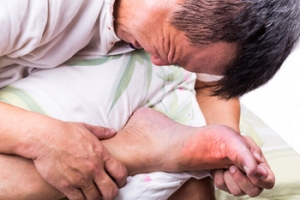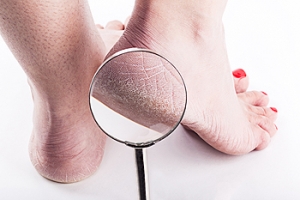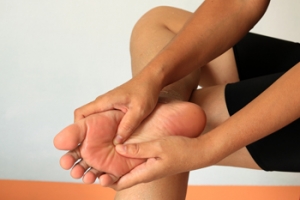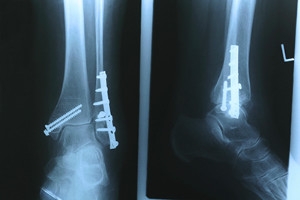Featured Articles

Falls Prevention
Elderly Americans are very susceptible to falls as they get older. Everyone experiences decreases in flexibility, balance, strength, and the senses as they age. This correlates to some eye-opening statistics. 1 in 4 Americans aged 65 and older fall each year. An elderly American is being treated for a fall in an emergency room every 11 seconds, and every 19 minutes, an older person dies from falling. In light of these striking statistics, one can see the importance of taking steps to prevent falls.
Finding an exercise program for the elderly is an excellent way to reduce the likelihood of falls. Look for an exercise program that improves strength and balance. Elderly people who live a more sedentary lifestyle, with little physical activity, are at an increased risk of falling. Wearing well-fitted footwear that provides good foot support and cushion will help prevent falls from poorly fitted shoes. Talking to a podiatrist about your susceptibility to falls and about inspecting your prescriptions will help to avoid any medication that could make falls more likely. Due to a decline in the senses among the elderly, having your eyes and hearing checked is recommended.
Around half of all falls occur in the household. Removing tripping hazards in the home and making it more accommodating to older persons can significantly reduce falls. Some notable household changes include increasing lighting around the house, installing grab bars in the shower and bathroom, and making sure the floor is clear of clutter. Other smart options include installing a shower chair, using rubber-bottomed rugs, and placing railings on both sides of stairwells.
Finally, discuss with a doctor and your family about your fear of falling. This will help to increase awareness among the population on the need for fall prevention. A lack of awareness on the matter, and a downplaying of importance are what increase the risks of falling. Following these tips can help to reduce the risk for yourself and your loved ones.
Foot Pain May Be a Result of Certain Medical Conditions
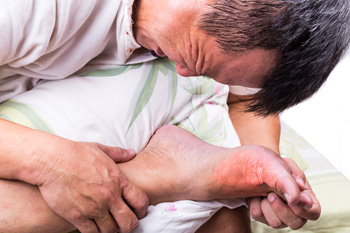 Many patients will experience swollen ankles or swollen feet periodically throughout their lives. This can happen for a variety of reasons, including a possible injury, arthritic conditions, or medical issues that may involve the kidneys. The foot will swell immediately if it is sprained or broken, which may cause pain and discomfort. Swollen feet may be a common condition among patients who have heart ailments. When this occurs, fluid may collect in the feet and ankles. Gravity can cause this to become worse during the day, so it may help to elevate the feet as often as possible. The arthritic condition that is known as gout can cause extreme foot pain. It typically affects the big toe, and may cause pain that is so extreme, it can be difficult to touch the toe. If you have any type of foot pain, it is strongly advised that you speak with a podiatrist as quickly as possible so they can help you to feel better.
Many patients will experience swollen ankles or swollen feet periodically throughout their lives. This can happen for a variety of reasons, including a possible injury, arthritic conditions, or medical issues that may involve the kidneys. The foot will swell immediately if it is sprained or broken, which may cause pain and discomfort. Swollen feet may be a common condition among patients who have heart ailments. When this occurs, fluid may collect in the feet and ankles. Gravity can cause this to become worse during the day, so it may help to elevate the feet as often as possible. The arthritic condition that is known as gout can cause extreme foot pain. It typically affects the big toe, and may cause pain that is so extreme, it can be difficult to touch the toe. If you have any type of foot pain, it is strongly advised that you speak with a podiatrist as quickly as possible so they can help you to feel better.
Foot Pain
Foot pain can be extremely painful and debilitating. If you have a foot pain, consult with one of our podiatrists from Romeo Foot & Ankle Clinic. Our doctors will assess your condition and provide you with quality foot and ankle treatment.
Causes
Foot pain is a very broad condition that could be caused by one or more ailments. The most common include:
- Bunions
- Hammertoes
- Plantar Fasciitis
- Bone Spurs
- Corns
- Tarsal Tunnel Syndrome
- Ingrown Toenails
- Arthritis (such as Gout, Rheumatoid, and Osteoarthritis)
- Flat Feet
- Injury (from stress fractures, broken toe, foot, ankle, Achilles tendon ruptures, and sprains)
- And more
Diagnosis
To figure out the cause of foot pain, podiatrists utilize several different methods. This can range from simple visual inspections and sensation tests to X-rays and MRI scans. Prior medical history, family medical history, and any recent physical traumatic events will all be taken into consideration for a proper diagnosis.
Treatment
Treatment depends upon the cause of the foot pain. Whether it is resting, staying off the foot, or having surgery; podiatrists have a number of treatment options available for foot pain.
If you have any questions, please feel free to contact our offices located in Washington and Shelby Townships, MI . We offer the newest diagnostic and treatment technologies for all your foot care needs.
Foot Pain
Our feet are arguably the most important parts of our bodies because they are responsible for getting us from place to place. However, we often don’t think about our feet until they begin to hurt. If you have pain in your feet, you need to first determine where on the foot you are experiencing it to get to the root of the problem. The most common areas to feel pain on the foot are the heel and the ankle.
Heel pain is most commonly attributed to a condition called plantar fasciitis. Plantar fasciitis occurs when the plantar fascia, which is the band of tough tissue connecting the heel bone to the toes becomes inflamed. Plantar fasciitis pain is usually worse in the morning, and it tends to go away throughout the day. If you have plantar fasciitis, you should rest your foot and do heel and foot muscles stretches. Wearing shoes with proper arch support and a cushioned sole has also been proven to be beneficial.
Some common symptoms of foot pain are redness, swelling, and stiffness. Foot pain can be dull or sharp depending on its underlying cause. Toe pain can also occur, and it is usually caused by gout, bunions, hammertoes, ingrown toenails, sprains, fractures, and corns.
If you have severe pain in your feet, you should immediately seek assistance from your podiatrist for treatment. Depending on the cause of your pain, your podiatrist may give you a variety of treatment options.
How Do Cracked Heels Develop?
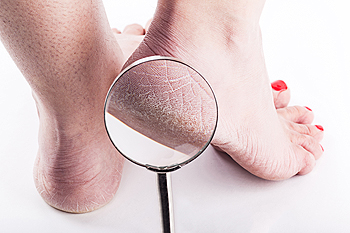 When pressure is put onto the pad underneath the heel, and the skin of the heel lacks moisture, it’s very likely that the skin will expand and crack due to lack of elasticity. Many other factors can play a role in developing cracked heels besides a lack of moisture. Some of these reasons can include obesity, frequently wearing open-back shoes, and standing for longer periods of time, especially on hard flooring. Certain foot conditions may also increase your chances of having cracked heels. These conditions may consist of diabetes, flat feet, heel spurs, fungal infections, and athlete’s foot, to name a few. To help treat cracked heels, it may be beneficial to apply a moisturizer to the affected area immediately after taking a bath or shower. It’s important that you also be mindful in choosing which soap or body washes you use, making sure to avoid those that are harsh or scented. For more advice and for help on how to best treat your cracked heels, we recommend you consult with a podiatrist for professional care.
When pressure is put onto the pad underneath the heel, and the skin of the heel lacks moisture, it’s very likely that the skin will expand and crack due to lack of elasticity. Many other factors can play a role in developing cracked heels besides a lack of moisture. Some of these reasons can include obesity, frequently wearing open-back shoes, and standing for longer periods of time, especially on hard flooring. Certain foot conditions may also increase your chances of having cracked heels. These conditions may consist of diabetes, flat feet, heel spurs, fungal infections, and athlete’s foot, to name a few. To help treat cracked heels, it may be beneficial to apply a moisturizer to the affected area immediately after taking a bath or shower. It’s important that you also be mindful in choosing which soap or body washes you use, making sure to avoid those that are harsh or scented. For more advice and for help on how to best treat your cracked heels, we recommend you consult with a podiatrist for professional care.
If the skin on your feet starts to crack, you may want to see a podiatrist to find treatment. If you have any concerns, contact one of our podiatrists from Romeo Foot & Ankle Clinic. Our doctors can provide the care you need to keep you pain-free and on your feet.
Cracked Heels
It is important to moisturize your cracked heels in order to prevent pain, bleeding, and infection. The reason cracked heels form is because the skin on the foot is too dry to support the immense pressure placed on them. When the foot expands, the dry skin on the foot begins to split.
Ways to Help Heal Them
- Invest in a good foot cream
- Try Using Petroleum Jelly
- Ease up on Soaps
- Drink Plenty of Water
Ways to Prevent Cracked Heels
- Moisturize After Showering
- Skip a Shower
- Keep Shower Water Lukewarm
- Don’t Scrub Your Feet
If you are unsure how to proceed in treating cracked heels, seek guidance from a podiatrist. Your doctor will help you with any questions or information you may need.
If you have any questions, please feel free to contact our offices located in Washington and Shelby Townships, MI . We offer the newest diagnostic and treatment technologies for all your foot care needs.
Solutions for Cracked Heels
Cracked heels may make you want to think twice about showing off your feet in warmer weather. However, cracked heels may be harmful to more than just the appearance of your feet. If deep fissures and cracks develop in your heels, they may make walking and standing painful for you. Additionally, these openings make way for germs to enter through your skin and cause infection.
There are several different causes of cracked heels. One of the most common reasons for this ailment is dry skin. This problem may make your keeps feel rough tight and itchy. Dry skin may be caused by cold air, extremely hot water, harsh soaps, and aging. Skin disorders such as eczema and psoriasis may eventually lead to dry skin. In some cases, complications may arise from cracked heels. Some of these complications are a loss of feeling in the heel, cellulitis, or a diabetic foot ulcer.
There are ways you can try to prevent getting cracked heels. One of the best ways to do so is to avoid wearing flip flops and sandals because these shoes increase your risk of drying out your feet. You should also avoid wearing shoes with a tall skinny heel, because these shoes cause your heel to expand sideways. At night, you should slather on a thick moisturizing cream on your feet and then cover them in socks to keep your feet moisturized overnight. Drinking water to stay hydrated is also a good way to ensure that your skin doesn’t become dry.
If you suffer from a severe case of cracked feet, you should make an appointment with your podiatrist to see what treatment methods are best for you.
Possible Causes of Morton’s Neuroma
 The medical condition that is known as Morton’s neuroma is defined as swelling around the nerves that pass between the bones in the foot. It can cause pain and discomfort at the ball of the foot, as well as a burning or numbing sensation in the toes. It can develop as a result of a muscular disorder, in addition to participating in certain sporting activities. Wearing high heels may cause this condition to develop, and this can be due to minimal room for the toes to move freely in. Effective treatments may consist of wearing custom made orthotics, and performing specific exercises and stretches that may help in the healing process. If you have any of these symptoms, it is advised that you are under the care of a podiatrist who can offer correct treatment techniques.
The medical condition that is known as Morton’s neuroma is defined as swelling around the nerves that pass between the bones in the foot. It can cause pain and discomfort at the ball of the foot, as well as a burning or numbing sensation in the toes. It can develop as a result of a muscular disorder, in addition to participating in certain sporting activities. Wearing high heels may cause this condition to develop, and this can be due to minimal room for the toes to move freely in. Effective treatments may consist of wearing custom made orthotics, and performing specific exercises and stretches that may help in the healing process. If you have any of these symptoms, it is advised that you are under the care of a podiatrist who can offer correct treatment techniques.
Morton’s neuroma is a very uncomfortable condition to live with. If you think you have Morton’s neuroma, contact one of our podiatrists of Romeo Foot & Ankle Clinic. Our doctors will attend to all of your foot care needs and answer any of your related questions.
Morton’s Neuroma
Morton's neuroma is a painful foot condition that commonly affects the areas between the second and third or third and fourth toe, although other areas of the foot are also susceptible. Morton’s neuroma is caused by an inflamed nerve in the foot that is being squeezed and aggravated by surrounding bones.
What Increases the Chances of Having Morton’s Neuroma?
- Ill-fitting high heels or shoes that add pressure to the toe or foot
- Jogging, running or any sport that involves constant impact to the foot
- Flat feet, bunions, and any other foot deformities
Morton’s neuroma is a very treatable condition. Orthotics and shoe inserts can often be used to alleviate the pain on the forefront of the feet. In more severe cases, corticosteroids can also be prescribed. In order to figure out the best treatment for your neuroma, it’s recommended to seek the care of a podiatrist who can diagnose your condition and provide different treatment options.
If you have any questions, please feel free to contact our offices located in Washington and Shelby Townships, MI . We offer the newest diagnostic and treatment technologies for all your foot care needs.
Morton's Neuroma
A neuroma is a thickening of nerve tissue and can develop throughout the body. In the foot, the most common neuroma is a Morton’s neuroma; this typically forms between the third and fourth toes. The thickening of the nerve is typically caused by compression and irritation of the nerve; this thickening can in turn cause enlargement and, in some cases, nerve damage.
Neuromas can be caused by anything that causes compression or irritation of the nerve. A common cause is wearing shoes with tapered toe boxes or high heels that force the toes into the toe boxes. Physical activities that involve repeated pressure to the foot, such as running or basketball, can also create neuromas. Those with foot deformities, such as bunions, hammertoes, or flatfeet, are more likely to develop the condition.
Symptoms of Morton’s neuroma include tingling, burning, numbness, pain, and the feeling that either something is inside the ball of the foot or that something in one’s shoe or sock is bunched up. Symptoms typically begin gradually and can even go away temporarily by removing one’s shoes or massaging the foot. An increase in the intensity of symptoms correlates with the increasing growth of the neuroma.
Treatment for Morton’s neuroma can vary between patients and the severity of the condition. For mild to moderate cases, padding, icing, orthotics, activity modifications, shoe modifications, medications, and injection therapy may be suggested or prescribed. Patients who have not responded successfully to less invasive treatments may require surgery to properly treat their condition. The severity of your condition will determine the procedure performed and the length of recovery afterwards.
Protective Boots and Stress Fractures
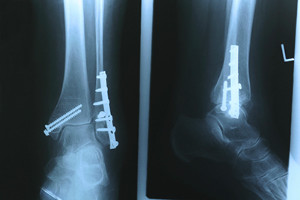 The bones in your foot which connect the ankle to the toes are referred to as the metatarsal bones. These bones can be affected if a stress fracture occurs. Stress fractures can be a common injury among people who frequently run or participate in jumping activities. Additionally, patients who have medical conditions that include osteoporosis or arthritis may be prone to developing this condition. It is considered to be a hairline fracture, and can cause considerable pain and discomfort. After a proper diagnosis is performed, which typically consists of having a bone scan or an MRI taken, treatment can begin. This may involve wearing a protective boot as the healing process takes place. Mild relief may be found when the affected foot is elevated, as this may help to reduce existing swelling. If you have a stress fracture, it is strongly recommended that you consult with a podiatrist who can properly treat this condition.
The bones in your foot which connect the ankle to the toes are referred to as the metatarsal bones. These bones can be affected if a stress fracture occurs. Stress fractures can be a common injury among people who frequently run or participate in jumping activities. Additionally, patients who have medical conditions that include osteoporosis or arthritis may be prone to developing this condition. It is considered to be a hairline fracture, and can cause considerable pain and discomfort. After a proper diagnosis is performed, which typically consists of having a bone scan or an MRI taken, treatment can begin. This may involve wearing a protective boot as the healing process takes place. Mild relief may be found when the affected foot is elevated, as this may help to reduce existing swelling. If you have a stress fracture, it is strongly recommended that you consult with a podiatrist who can properly treat this condition.
Activities where too much pressure is put on the feet can cause stress fractures. To learn more, contact one of our podiatrists from Romeo Foot & Ankle Clinic. Our doctors can provide the care you need to keep your pain free and on your feet.
Dealing with Stress Fractures of the Foot and Ankle
Stress fractures occur in the foot and ankle when muscles in these areas weaken from too much or too little use. The feet and ankles then lose support when walking or running from the impact of the ground. Since there is no protection, the bones receive the full impact of each step. Stress on the feet can cause cracks to form in the bones, thus creating stress fractures.
What Are Stress Fractures?
Stress fractures occur frequently in individuals whose daily activities cause great impact on the feet and ankles. Stress factors are most common among:
- Runners
- People affected with Osteoporosis
- Tennis or basketball players
- Gymnasts
- High impact workouts
Symptoms
Pain from the fractures occur in the area of the fractures and can be constant or intermittent. It will often cause sharp or dull pain with swelling and tenderness. Engaging in any kind of activity which involves high impact will aggravate pain.
If you have any questions please feel free to contact our offices located in Washington and Shelby Townships, MI . We offer the newest diagnostic and treatment technologies for all your foot and ankle needs.
Stress Fractures of the Foot and Ankle
Our bones are important aspects of our body and they are constantly changing. The heavier the workload for a bone, the more likely it is that calcium will be placed in it. When a bone isn’t used often, there won’t be much calcium within it. When stress from repetitive loads prevent the bone from being able to repair itself, cracks will start to form. Stress fractures are defined as cracks in a bone that result from repetitive force, such as overuse.
The most common cause of stress fractures is a sudden increase in intensity and duration of physical activity. For example, if you begin to run long distances without working your way into doing so, you will be more likely to develop a stress fracture.
Common symptoms of stress fractures are pain and swelling near the weight bearing area on the injured bone. When initial x-rays are performed, it is possible that the fracture will not show up. However, once the stress on the area continues, the damage will increase, and the fracture will be severe enough to show up on an x-ray. Certain parts of the foot are more likely to develop stress fractures than others. Areas that typically have these fractures are: the metatarsals, the navicular bone, the calcaneus, tibia, and fibula.
Since women are at an increased risk of developing osteoporosis, they are twice as likely as men to sustain a stress fracture. Additionally, old age causes a decrease in bone mineral density which is why elderly people are also likely to develop these fractures.
It is important for you to be professionally diagnosed by a podiatrist if you suspect you have a stress fracture, because there are other injuries that can easily be mistaken for a fracture. Sprains, strains, shin splints, plantar fasciitis, and Morton’s neuroma can all easily be mistaken for stress fractures in the foot. Your podiatrist will likely ask you a series of questions to determine what type of pain you are experiencing. These questions will help your doctor identify whether you have a stress fracture.
The best method of treatment for a stress fracture is rest. Additionally, a walking boot, cast, or crutches, will help rest the area that is injured. The typical healing time for stress fractures is 4-12 weeks, however this depends on which bone is involved.


